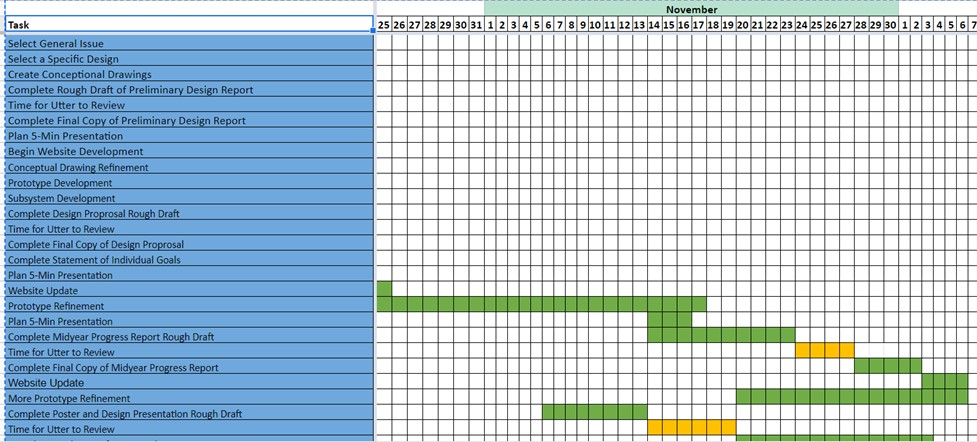To keep track of the hours worked by each student, which tasks have been worked on, and who was responsible for each task, the time keeping system known as the Scrum Agile Mindset [28] was implemented. The system involves a record of hours each team member can work outside of class in a given week estimated by each student at the beginning of that two week period. Each team goal is listed on the spreadsheet and separated into short term and long term goals with estimated times needed to achieve each goal. Team members record the amount of time they actually work on each goal and every increment of work is tallied up into the amount of time each team member worked that week and into how much time has been dedicated to working towards each goal.
The team implemented internal deadlines to complete a rough draft several days prior to the actual deadline for any report or presentation the group must deliver. This extra time allowed enough time for team members to revise any parts of the report as well as for Professor Utter to offer any feedback. Additionally, this extra time gave the copy editors enough time to look through reports and for any team members to complete missing or unfinished sections of the report.
The team has completed the brainstorming process in determining the topic of the project and conceptual designs as well as initial website design. Additionally, the team has fully modeled the wheelchair used as the base for the project in Fusion360. Currently, the team is focused on working within the propulsion, effort sensor, and electro-mechanical integration subteams to develop the subsystems of the project. In addition, the team is currently working on conducting interviews with wheelchair users and on sending out surveys, (See Health Care Provider Survey and Wheelchair Users Interview Availability Form) , to related healthcare professionals, the responses to both of which will help the team further refine the final design.
The team used Gantt charts for team scheduling, as seen in Appendix E. As seen in Table E.1 (See Below) the team schedule uses a color coding system to show the type of event and duration of a specific task. The Gantt chart also shows the duration of each task and deliverable due dates in respective tabs of the excel sheet (Table E.3 and E.4 (See Below)) as well as if the task applies to the whole team or to one of the subteams. As the team worked through tasks, the color of each task changed to represent progress from future event to current event then to complete. Each group of tasks is color coordinated by the subsystem in the leftmost column.
Each subteam has completed their respective goals. Each team has already decided the components they need and created full CAD assemblies. The Electro-Mechanical Integration team has already gathered all of the subsystem components and the Effort Sensing and Propulsion subteams have completed mathematical models and analyses including structural and thermodynamic evaluations. For further information on the subteams’ current progress and next steps, please refer to the Planned Approach – Subsystems and Planned Approach – Next Steps respectively.
The team goal for the end of the semester was to have a completed CAD model of each subsystem including every physical aspect of the system down to the fasteners as well as an accurate bill of all of the materials. This is reflected in the current schedule. Overall, this has put the team in a good position to complete a fully functional wheelchair add-on by the end of the school year.
Table E.1: Semester Gantt Chart Tasks and timeline for the month of November for the full team
Table E.2: Semester Gantt Chart Tasks and timeline for the month of October for the subteams
Table E.3 Semester Gantt Chart Tasks and Duration

Table E.4 Semester Gantt Chart Deliverables and Due Dates
*For the entire timeline https://drive.google.com/file/d/1blwdfm0jCRODBc5OberlfQLKv9zi5fbT/view?usp=sharing


